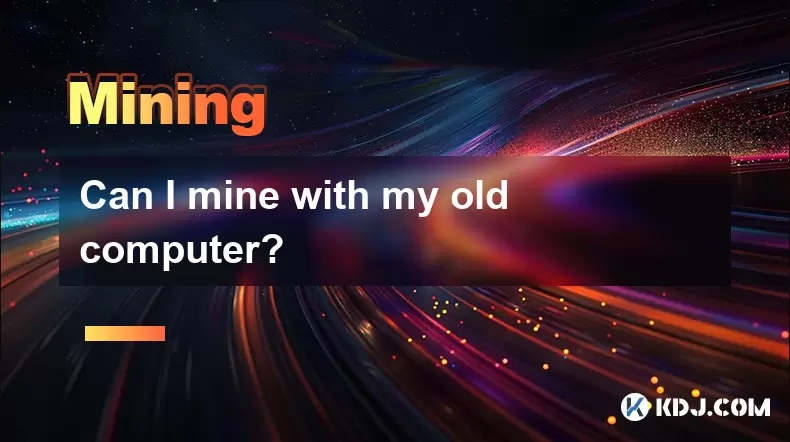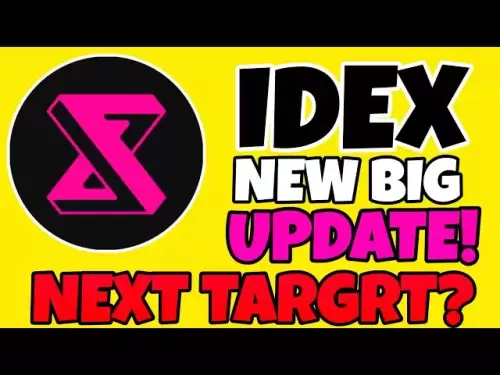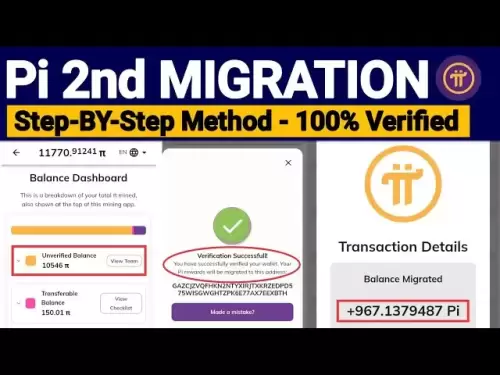-
 Bitcoin
Bitcoin $119,161.9671
1.52% -
 Ethereum
Ethereum $2,995.0722
2.34% -
 XRP
XRP $2.8555
5.32% -
 Tether USDt
Tether USDt $1.0002
0.00% -
 BNB
BNB $692.9308
1.48% -
 Solana
Solana $162.9611
1.87% -
 USDC
USDC $0.9999
0.00% -
 Dogecoin
Dogecoin $0.2014
2.84% -
 TRON
TRON $0.3032
0.90% -
 Cardano
Cardano $0.7464
6.51% -
 Hyperliquid
Hyperliquid $49.1533
5.71% -
 Stellar
Stellar $0.4773
24.77% -
 Sui
Sui $3.4979
3.93% -
 Chainlink
Chainlink $15.8552
6.01% -
 Hedera
Hedera $0.2401
23.85% -
 Bitcoin Cash
Bitcoin Cash $510.0474
0.97% -
 Avalanche
Avalanche $21.5550
4.82% -
 UNUS SED LEO
UNUS SED LEO $9.0389
-0.47% -
 Shiba Inu
Shiba Inu $0.0...01340
2.27% -
 Toncoin
Toncoin $2.9910
0.62% -
 Litecoin
Litecoin $96.4406
4.34% -
 Polkadot
Polkadot $4.0359
4.59% -
 Monero
Monero $338.4759
2.80% -
 Uniswap
Uniswap $8.6460
4.01% -
 Dai
Dai $0.9999
0.00% -
 Ethena USDe
Ethena USDe $1.0007
0.03% -
 Pepe
Pepe $0.0...01254
3.26% -
 Bitget Token
Bitget Token $4.3969
0.79% -
 Aave
Aave $312.2641
3.98% -
 Bittensor
Bittensor $397.0731
4.17%
Can I mine with my old computer?
Mining with an old computer is possible but often unprofitable due to low hashrate and high electricity costs, though lightweight options like Monero may offer modest returns.
Jul 13, 2025 at 10:36 pm

Understanding the Feasibility of Mining with an Old Computer
Mining cryptocurrency involves solving complex mathematical problems using computational power. The efficiency and profitability of mining largely depend on the hardware being used. Older computers, especially those built before 2015, typically lack the processing power and energy efficiency required for modern mining algorithms. However, it's still technically possible to mine with an old computer, although the returns may not justify the effort or electricity costs.
The type of cryptocurrency you're trying to mine also plays a crucial role in determining feasibility. Some cryptocurrencies like Monero (XMR) are designed to be mined using CPUs, making them more suitable for older machines. Others, such as Bitcoin (BTC), require specialized ASIC miners that far outperform standard PCs.
Hardware Requirements for Mining
To assess whether your old computer can mine effectively, consider the following components:
- Processor (CPU): Older CPUs may support mining, but their hashrate will be significantly lower than newer models.
- Graphics Card (GPU): Most profitable mining operations rely on GPUs. If your system lacks a dedicated GPU or uses an outdated model, performance will suffer.
- RAM: At least 4GB of RAM is recommended, though 8GB or more is ideal for smoother operation.
- Storage: While storage isn't a major factor, having enough space for mining software and blockchain data is necessary.
- Cooling System: Mining generates heat, so proper ventilation and cooling are essential, especially for older systems prone to overheating.
If your machine meets these basic requirements, it might be worth experimenting with lightweight mining setups.
Selecting the Right Cryptocurrency to Mine
Choosing the appropriate cryptocurrency is critical when working with limited resources. Here are some options that are relatively easier to mine with older hardware:
- Monero (XMR): This privacy-focused coin supports CPU mining, making it accessible for older machines.
- Electroneum (ETN): Designed for mobile and low-power devices, this coin can be mined on modest hardware.
- Zcash (ZEC): While GPU mining is preferred, some users have successfully mined Zcash using powerful CPUs.
Each of these coins uses different algorithms—RandomX for Monero, ProgPoW for Electroneum, and Equihash for Zcash—so ensure the mining software you choose supports the algorithm of the coin you’re targeting.
Setting Up Mining Software
Once you've decided on the cryptocurrency, the next step is installing and configuring mining software. Follow these steps carefully:
- Download Mining Software: For Monero, XMRig is a popular choice. For Zcash, EWBF or NiceHash can be used depending on your hardware.
- Install Required Dependencies: Older operating systems may need updates or additional libraries to run the latest mining tools.
- Configure the Miner: Edit the configuration file to include your wallet address, mining pool address, and worker name.
- Run the Miner: Launch the miner and monitor its performance using built-in tools or third-party monitoring software.
Make sure to test the setup at first with low intensity settings to avoid crashing your system. Also, keep track of temperature and fan speed, as overheating is a common issue with older hardware.
Mining Pools vs Solo Mining
Joining a mining pool increases the likelihood of earning consistent rewards, especially with weaker hardware. Solo mining is generally impractical unless you have substantial computing power. When choosing a mining pool:
- Look for pools with low fees and good uptime.
- Check if the pool supports the cryptocurrency you want to mine.
- Ensure the pool provides easy-to-use interfaces and clear payout structures.
Popular mining pools include Minexmr for Monero, Flypool for Ethereum-based coins, and ZPool for Zcash. Registering an account and linking your mining rig to the pool usually requires only a few steps, including inputting your wallet address and setting up a worker identifier.
Evaluating Power Consumption and Profitability
Before running your old computer continuously for mining, evaluate its power consumption and potential earnings. Use online calculators to estimate daily income based on your hardware's hashrate and current market conditions. Consider the following:
- Electricity Cost: Calculate how much your local utility charges per kilowatt-hour (kWh).
- Daily Earnings vs Expenses: Subtract power costs from daily mining revenue to determine net profit.
- System Wear and Tear: Continuous mining can shorten the lifespan of aging components.
In many cases, the cost of electricity outweighs earnings, especially with inefficient hardware. Be realistic about whether mining makes financial sense for your specific situation.
Frequently Asked Questions
Q: Can I mine without joining a mining pool?
A: Yes, but solo mining is rarely profitable unless you have high-performance hardware. It’s more practical to join a pool to receive regular, albeit smaller, payouts.
Q: Is mining safe for my old computer?
A: Mining puts significant stress on hardware. If your system lacks adequate cooling or stable power supply, long-term mining could lead to component failure.
Q: Do I need a special wallet to receive mined coins?
A: Yes, you must use a wallet compatible with the cryptocurrency you're mining. Popular choices include Monero GUI Wallet for XMR and Electrum-Zcash for ZEC.
Q: Can I mine while using my computer normally?
A: Yes, but mining consumes CPU/GPU resources, which can cause lag or slowdowns during intensive tasks like gaming or video editing.
Disclaimer:info@kdj.com
The information provided is not trading advice. kdj.com does not assume any responsibility for any investments made based on the information provided in this article. Cryptocurrencies are highly volatile and it is highly recommended that you invest with caution after thorough research!
If you believe that the content used on this website infringes your copyright, please contact us immediately (info@kdj.com) and we will delete it promptly.
- Ruvi AI: The Audited Token Primed for 100x Gem Status
- 2025-07-14 06:50:12
- Bitcoin's New Highs: Retail Interest and the Allure of Crypto Presales
- 2025-07-14 07:10:11
- Dogwifhat (WIF) Price Prediction: Bullish MACD Signals Potential Breakout
- 2025-07-14 07:10:11
- Ethereum Flips Bitcoin: Futures Volumes and the Altcoin Surge
- 2025-07-14 06:30:11
- Czech National Bank's Crypto Leap: Coinbase, Palantir, and the Future of Finance
- 2025-07-14 06:30:11
- BlockDAG's BEAT Vesting Pass: Dominating Crypto While HBAR Shows Strength
- 2025-07-14 04:30:12
Related knowledge

How are crypto mining profits taxed?
Jul 14,2025 at 12:28am
Understanding Cryptocurrency Mining and TaxationCryptocurrency mining involves validating transactions on a blockchain network and earning rewards in ...

How to keep a mining rig cool
Jul 12,2025 at 01:42pm
Understanding the Importance of Cooling in Mining RigsCryptocurrency mining is an intensive process that places heavy demand on hardware components, p...

How much does it cost to start crypto mining?
Jul 13,2025 at 12:22am
Understanding the Basic Costs of Crypto MiningStarting crypto mining involves several upfront and ongoing expenses. The primary costs include hardware...

What is the most profitable crypto to mine?
Jul 13,2025 at 07:00am
Understanding Mining Profitability in CryptocurrencyWhen evaluating the most profitable crypto to mine, it's essential to consider several factors tha...

What do I need to start mining crypto?
Jul 13,2025 at 12:28am
Understanding the Basics of Crypto MiningCrypto mining is the process by which transactions are verified and added to a blockchain, and new coins are ...

How does crypto mining work?
Jul 13,2025 at 11:01am
Understanding the Basics of Crypto MiningCrypto mining is the process through which new cryptocurrency coins are introduced into circulation and trans...

How are crypto mining profits taxed?
Jul 14,2025 at 12:28am
Understanding Cryptocurrency Mining and TaxationCryptocurrency mining involves validating transactions on a blockchain network and earning rewards in ...

How to keep a mining rig cool
Jul 12,2025 at 01:42pm
Understanding the Importance of Cooling in Mining RigsCryptocurrency mining is an intensive process that places heavy demand on hardware components, p...

How much does it cost to start crypto mining?
Jul 13,2025 at 12:22am
Understanding the Basic Costs of Crypto MiningStarting crypto mining involves several upfront and ongoing expenses. The primary costs include hardware...

What is the most profitable crypto to mine?
Jul 13,2025 at 07:00am
Understanding Mining Profitability in CryptocurrencyWhen evaluating the most profitable crypto to mine, it's essential to consider several factors tha...

What do I need to start mining crypto?
Jul 13,2025 at 12:28am
Understanding the Basics of Crypto MiningCrypto mining is the process by which transactions are verified and added to a blockchain, and new coins are ...

How does crypto mining work?
Jul 13,2025 at 11:01am
Understanding the Basics of Crypto MiningCrypto mining is the process through which new cryptocurrency coins are introduced into circulation and trans...
See all articles
























































































